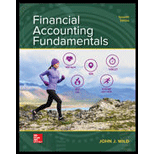
Cash Equivalents:
Cash equivalents are part of liquid investments. It includes marketable securities, physical cash and commercial paper.
Cash flow is a statement which shows flow of cash and cash equivalents as moving inward and outward of the business in a given time. In other words, cash flow statement shows cash generated or used by a company.
Inventory:
Inventory is an asset of the company which includes three types of goods: work in progress, raw material and finished goods which are in the process of making or already ready to be sold in the market. In other words inventory is goods which are unsold and would be sold.
1.
To identify: Total amount of cash and cash equivalents and its percentage in reference of total current assets, total current liabilities, total shareholder’s equity and total assets for 2015 and 2017.
Explanation of Solution
Balance of cash and cash equivalents as on September26, 2014and 2015 are as follows:
| Particulars | Balance as on September26, 2015($) | % of cash and cash equivalents(%) | Balance as on September27, 2014($) | % of cash and cash equivalents(%) |
| Cash and its equivalents | 21,120 | 13,844 | ||
| Current Assets | 89,378 | 23.6 | 68,531 | 20.2 |
| Current Liabilities | 80,610 | 26.2 | 63,448 | 21.8 |
| Shareholder’s Equity | 119,355 | 17.7 | 111,547 | 12.4 |
| Net Assets | 290,479 | 7.3 | 231,839 | 6.0 |
Table (1)
Review of trend:
From above data, it is observed that cash and cash equivalents have increased in 2017 as compared to 2016.
Hence, it is ascertained that liquidity position of A Company has increased slightly as compared to last year .
Working notes:
Formula to calculate % of cash and cash equivalent is,
Percent of cash and cash equivalents on September 26, 2015 proportionate to:
Calculation of current assets %,
Calculation of current liabilities %,
Calculation of shareholder’s equity %,
Calculation of net assets %,
Percent of cash and cash equivalents on September 27, 2014 proportionate to:
Calculation of current assets %,
Calculation of current liabilities %,
Calculation of shareholder’s equity %,
Calculation of net assets %,
2.
Cash and cash equivalents percentage change in the beginning and ending of the year through the information contained in cash flow statement of September26, 2015 and September27, 2014.
2.
Explanation of Solution
Formula to calculate the percentage change in cash and cash equivalents is,
2015
Given,
Cash and cash equivalents in the beginning of 2015 is $13,844.
Cash and cash equivalents at the end of the year is $21,120.
Substitute $13,844 for cash and cash equivalents in the beginning of the 2015 and $21,120 at the end of the year.
Hence, percentage change represents an increase of 52.6%.
2014
Given,
Cash and cash equivalents in the beginning of 2014 is $14,259
Cash and cash equivalents at the end of the year is $13,844.
Substitute $14,259 for cash and cash equivalents in the beginning of the 2015 and $13,844 at the end of the year.
Hence, percentage change represents a decrease of 2.9%.
3.
Day’s sales uncollected as of September26, 2015 and September27, 2014.
3.
Explanation of Solution
Day’s sales uncollected imply how much days a company takes to collect its accounts receivables.
Formula to calculate day’s sales uncollected is,
2015
Given,
Net sales are $233,715.
Substitute $16,849 for accounts receivable, and $233,715 for net sales.
2014
Given,
Accounts receivable is $17,460.
Net sales are $182,795.
Substitute $17,460 for accounts receivable, and $182,795 for net sales.
Hence, day’s sales uncollected are accounted for 2014 is 34.86 days and for 2015 is 26.31 days.
- Thus, it is concluded that A Company has improved slightly in order to collect its receivable as now it would take 8.55 less days to collect receivables.
- Accounts receivables are important part of the company as it indicates about the turnover. So, company should take steps for its improvements.
4.
Day’s sales uncollected as of September26, 2015.
4.
Explanation of Solution
Day’s sales uncollected imply how much days a company takes to collect its accounts receivables.
Given info,
Accounts receivable is $16,849
Net sales are $233,715.
Formula to calculate day’s sales uncollected is,
Substitute $16,849 for accounts receivable and $233,715 for net sales.
Hence, day’s sales uncollected are accounted for 26.31 days .
Thus, company would take 8.55 more days to collect its receivables in the year 2015 as compared to 2014.
Want to see more full solutions like this?
Chapter 6 Solutions
FINANCIAL ACCT.FUND.(LOOSELEAF)
- Please provide the solution to this general accounting question with accurate financial calculations.arrow_forwardI am looking for the most effective method for solving this financial accounting problem.arrow_forwardA company reported the following information for its most recent year of operation: purchases, $175,000; beginning inventory, $35,000; and cost of goods sold, $180,000. How much was the company's ending inventory?need helparrow_forward
- I need help with this problem and accountingarrow_forwardAt the beginning of the year, Vertex Technologies, Inc. determined that estimated overhead costs would be $540,000, while actual overhead costs for the year totaled $562,000. Furthermore, it was determined that the estimated allocation basis would be 60,000 machine hours, while production actually required 63,500 machine hours. What was the dollar amount of underallocated or overallocated manufacturing overhead?arrow_forwardArmani Manufacturing produces widgets at a variable cost of $12 per unit. Fixed costs are $180,000 per year. If each widget sells for $27, how many units must be sold to break even?arrow_forward
- Principles of Accounting Volume 1AccountingISBN:9781947172685Author:OpenStaxPublisher:OpenStax CollegeBusiness Its Legal Ethical & Global EnvironmentAccountingISBN:9781305224414Author:JENNINGSPublisher:Cengage
- Century 21 Accounting Multicolumn JournalAccountingISBN:9781337679503Author:GilbertsonPublisher:Cengage




